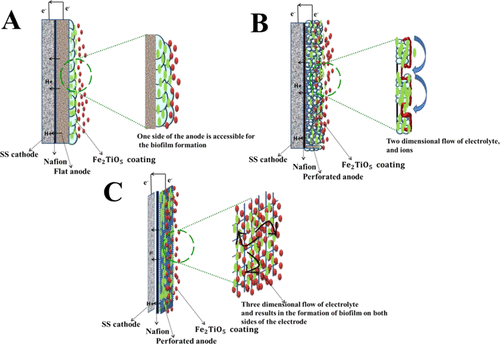当前位置:
X-MOL 学术
›
ACS Appl. Bio Mater.
›
论文详情
Our official English website, www.x-mol.net, welcomes your
feedback! (Note: you will need to create a separate account there.)
Tuning of Surface Characteristics of Anodes for Efficient and Sustained Power Generation in Microbial Fuel Cells
ACS Applied Bio Materials ( IF 4.6 ) Pub Date : 2020-08-27 , DOI: 10.1021/acsabm.0c00753 Bhuvanendran Revamma Sreelekshmy 1 , Arya Jayalekshmy Rajappan 2 , Rubina Basheer 1 , Vipinlal Vasudevan 2 , Anjana Ratheesh 1 , Muraleedharan Sheela Meera 2 , Chanassery Vinayababu Geethanjali 2 , Sheik Muhammadhu Aboobakar Shibli 2, 3
ACS Applied Bio Materials ( IF 4.6 ) Pub Date : 2020-08-27 , DOI: 10.1021/acsabm.0c00753 Bhuvanendran Revamma Sreelekshmy 1 , Arya Jayalekshmy Rajappan 2 , Rubina Basheer 1 , Vipinlal Vasudevan 2 , Anjana Ratheesh 1 , Muraleedharan Sheela Meera 2 , Chanassery Vinayababu Geethanjali 2 , Sheik Muhammadhu Aboobakar Shibli 2, 3
Affiliation

|
The present study reports about the fabrication of a three-dimensional (3D) macroporous steel-based scaffold as an anode to promote specifically bacterial attachment and extracellular electron transfer to achieve power density as high as 1184 mW m–2, which is far greater than that of commonly used 3D anode materials. The unique 3D open macroporous configuration of the anode and the microstructure generated by the composite coating provide voids for the 3D bacterial colonization of electroactive biofilms. This is attributed to the sizeable interfacial area per unit volume provided by the 3D corrugated electrode that enhanced the electrochemical reaction rate compared to that of the flat electrode, which favors the enhanced mass transfer and substrate diffusion at the electrode/electrolyte interface and thereby increases the charge transfer by reducing the electrode overpotential or interfacial resistance. In addition, bacterial infiltration into the interior of the anode renders large reaction sites for substrate oxidation without the concern of clogging and biofouling and thereby improves direct electron transfer. A very low overpotential (−27 mV) with a very low internal resistance (7.104 Ω cm2) is achieved with the fabricated microbial fuel cell (MFC) that has a modified 3D corrugated electrode. Thus, easier and faster charge transfer at the electrode–electrolyte interface is confirmed. The study presents a revolutionary practical approach in the development of highly efficient anode materials that can ensure easy scale-up for MFC applications.
中文翻译:

调整阳极表面特性以实现微生物燃料电池中高效和持续的发电
本研究报告了制造三维 (3D) 大孔钢基支架作为阳极,以促进特异性细菌附着和细胞外电子转移,从而实现高达 1184 mW m –2的功率密度,远大于常用的3D负极材料。阳极独特的 3D 开放大孔结构和复合涂层产生的微结构为电活性生物膜的 3D 细菌定植提供了空隙。这归因于 3D 波纹电极提供的每单位体积相当大的界面面积,与平面电极相比提高了电化学反应速率,这有利于电极/电解质界面处的传质和底物扩散,从而增加通过降低电极过电位或界面电阻进行电荷转移。此外,细菌渗入阳极内部为底物氧化提供了大的反应位点,而无需担心堵塞和生物污染,从而改善了直接电子转移。非常低的过电势 (-27 mV) 和非常低的内阻 (7.104 Ω cm2 ) 是通过具有改进的 3D 波纹电极的制造的微生物燃料电池 (MFC) 实现的。因此,证实了在电极 - 电解质界面处更容易和更快的电荷转移。该研究提出了一种开发高效负极材料的革命性实用方法,可确保轻松扩大 MFC 应用的规模。
更新日期:2020-09-21
中文翻译:

调整阳极表面特性以实现微生物燃料电池中高效和持续的发电
本研究报告了制造三维 (3D) 大孔钢基支架作为阳极,以促进特异性细菌附着和细胞外电子转移,从而实现高达 1184 mW m –2的功率密度,远大于常用的3D负极材料。阳极独特的 3D 开放大孔结构和复合涂层产生的微结构为电活性生物膜的 3D 细菌定植提供了空隙。这归因于 3D 波纹电极提供的每单位体积相当大的界面面积,与平面电极相比提高了电化学反应速率,这有利于电极/电解质界面处的传质和底物扩散,从而增加通过降低电极过电位或界面电阻进行电荷转移。此外,细菌渗入阳极内部为底物氧化提供了大的反应位点,而无需担心堵塞和生物污染,从而改善了直接电子转移。非常低的过电势 (-27 mV) 和非常低的内阻 (7.104 Ω cm2 ) 是通过具有改进的 3D 波纹电极的制造的微生物燃料电池 (MFC) 实现的。因此,证实了在电极 - 电解质界面处更容易和更快的电荷转移。该研究提出了一种开发高效负极材料的革命性实用方法,可确保轻松扩大 MFC 应用的规模。











































 京公网安备 11010802027423号
京公网安备 11010802027423号